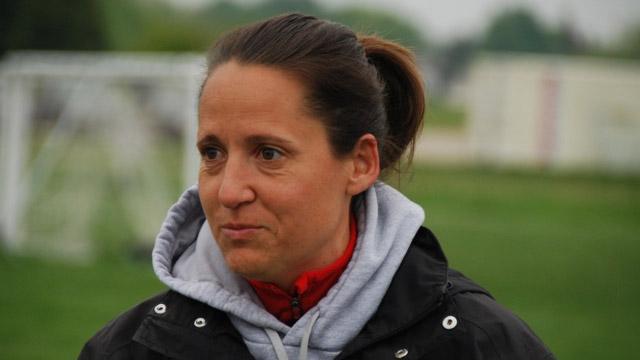 Wilkins as a former player.
Wilkins as a former player.Where are all the female coaches? Part 2

February 23, 2012
Part 2 in a 2-part article. Click here to read Part 1.
College soccer is the only arena with a sizeable percentage of female coaches; a study done by Marquette University’s Brian Brush and Gregory Naples put the figure at 33.1 percent for all three divisions in 2008.
ECNL Commissioner Sarah Kate Noftsinger spoke about the "outstanding" female coaches in college soccer, and said she hopes to attract those types of coaches to the elite club game in the near future.
Wisconsin’s Paula Wilkins is one of those accomplished coaches in the college game. She led Penn State to the College Cup, the Final Four for soccer, twice in four years in the early 2000s, and is now on the way to building the Badgers into a national powerhouse.
Wilkins cites her former coaches as guiding her into the coaching profession.
“The reason I became a coach had a lot to do with my college coach Jim Rudy and club coach Scott Frey,” said Wilkins. “They saw it in me before I did. They both supported me in coaching.”
Wilkins was informed in the pre-interview request that the question about why more women decide to coach in college than at the elite club level would be brought up.
 Wilkins as a former player.
Wilkins as a former player.“I think club soccer is a little challenging for raising a family because in the evenings you are running practice and away from home every weekend.”
Another reason for the difference between the percentage of female coaches in college and club can be boiled down to the opportunity. College soccer offers a chance for females to return to school and further their education, but also stay involved in the game.
Wilkins, for instance, cited the encouragement that Pat Farmer gave her when she started on his staff at Penn State, while also working toward her Master’s degree.
There is no similarity to that situation in youth club soccer.
Professor Cindra Kamphoff, who has a Ph.D. in Sport and Exercise Psychology and published papers on the topic of female coaches, said it is not just an issue about soccer, but sport in general.
“It is not only a national issue, it is a worldwide issue,” Kamphoff told TopDrawerSoccer.com. “It is difficult to find just one reason. It is a multifaceted issue and there are multiple reasons why there is a lack of females coaching not only in soccer but in all sports.”
During various interviews for this article, multiple individuals spoke about the benefit of Title IX for females in sport, but as Kamphoff noted Title IX actually decreased the amount of women in coaching and administrative positions.
When Title IX passed in 1972, athletic departments merged from separate male and female departments to an all-encompassing department. According to statistics from Brush and Naples, the amount of female head coaches in college soccer has declined slightly since its high in 1979, 35.7 percent to 33.1 percent.
“Male athletic directors tend to hire male coaches, there is quite a bit of data on this, and then women are excluded from these conversations,” said Kamphoff about a study on the burnout rate of female coaches. “When you get that gender bias in the field, it does not make you want to stay.”
The theory lends itself to youth soccer as well, as men run many clubs from the office to the field. There is only one female Technical Director listed on the ECNL website of the 66 clubs in the league.
“In a lot of these club systems, you have this sort of 'old boys club',” said Welsh. “A lot of clubs are male dominated, even in the club I am in now; there is maybe one or two female coaches involved.
“I think a lot of the good and smart clubs are looking for female coaches. When I was asking around, a lot of people were saying they really wanted female coaches.”
Professor Wade Gilbert, who holds a Ph.D. in Psychopedagogy, offered another theory about the lack of female coaches in the youth game.
“My theory on that, based on my own experience, is it is pretty hard to just jump in to a U12 or U14 team,” said Gilbert. “The coaches for the U6 and U8s are mostly men, because the kids who play soccer typically have siblings, so who has to stay home and watch the younger kids, the mom. Then, the dad just follows along from U6 to U7 and so on, and the mom misses that window.”
There are multiple theories as to why this phenomenon exists, but little in terms of solutions.
Gilbert, Kamphoff, and Noftsinger all suggested that it might be the encouragement that is lacking. Both professors noted that some women do not even view coaching as a potential career.
Perhaps that will change as more women slowly recognize the role models in the coaching ranks and move to follow in the footsteps of Welsh, Walker, and the other female club coaches.
Til then though, the gross underrepresentation of females in the profession persists with little attention.
J.R. Eskilson is a staff reporter at TopDrawerSoccer.com. Follow him on  or send him an email.
or send him an email.
 or send him an email.
or send him an email.Headlines
- Recruiting Roundup: May 12-18
- 2025 Women's Division I Transfer Tracker
- How Do I Get Scouted by TopDrawerSoccer?
-
2025 Men's Big South Breakout Candidates

-
Commitments: Heading South to Texas

-
2025 Men's Big East Breakout Candidates

-
Pacific NW High School Roundup - May

-
Mid-Atlantic High School Roundup - May

-
Commitments: Top CB Picks Indiana

-
ECNL Boys NC U14 Players to Watch

IMG Academy Top 200/150 Rankings



